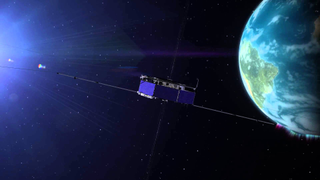High-Flying NASA Mission Sets New GPS World Record

A NASA mission's GPS prowess is now part of the record books: The Magnetospheric Multiscale (MMS) mission just broke a Guinness World Record for highest altitude fix of a GPS signal.
The four MMS satellites set the new space record by using GPS navigation at an altitude of 43,500 miles (70,000 kilometers) above Earth's surface. The satellites use GPS, which is a navigation system that pinpoints locations by checking in with devoted satellites in orbit, to stay in a tight flying formation as they survey Earth's magnetic field.
This isn't the only time that MMS broke a record. Previously, it managed the closest flying formation between several spacecraft, with only 4.5 miles (7.24 km) separating the four satellites. [NASA's Magnetospheric Multiscale Mission in Pictures]

MMS are also the fastest-traveling craft to use a GPS receiver, reaching 22,000 mph (35,405 km/h) when the mission is at its closest point to Earth along its orbit.
The primary mission of MMS is to help scientists understand Earth's magnetosphere, which is the region surrounding our planet where Earth's magnetic field is dominant (as opposed to the magnetic field of space itself).
"The mission uses four individual satellites that fly in a pyramid formation to map magnetic reconnection — a process that occurs as the sun and Earth's magnetic fields interact," officials from NASA's Goddard Space Flight Center said in a statement. "Precise GPS tracking allows the satellites to maintain a tight formation and obtain high resolution three-dimensional observations."
Studying magnetic connection helps scientists understand phenomena ranging from flares on the sun's surface to auroras in Earth's atmosphere, NASA added.
Get the Space.com Newsletter
Breaking space news, the latest updates on rocket launches, skywatching events and more!
The satellites will go to a higher orbit to look at a different region of the magnetosphere in spring, beginning Phase 2 of the mission. During that stage, the satellites are expected to at least double the GPS record they set, officials said.
Follow Elizabeth Howell @howellspace, or Space.com @Spacedotcom. We're also on Facebook and Google+. Original article on Space.com.
Join our Space Forums to keep talking space on the latest missions, night sky and more! And if you have a news tip, correction or comment, let us know at: community@space.com.

Elizabeth Howell (she/her), Ph.D., is a staff writer in the spaceflight channel since 2022 covering diversity, education and gaming as well. She was contributing writer for Space.com for 10 years before joining full-time. Elizabeth's reporting includes multiple exclusives with the White House and Office of the Vice-President of the United States, an exclusive conversation with aspiring space tourist (and NSYNC bassist) Lance Bass, speaking several times with the International Space Station, witnessing five human spaceflight launches on two continents, flying parabolic, working inside a spacesuit, and participating in a simulated Mars mission. Her latest book, "Why Am I Taller?", is co-written with astronaut Dave Williams. Elizabeth holds a Ph.D. and M.Sc. in Space Studies from the University of North Dakota, a Bachelor of Journalism from Canada's Carleton University and a Bachelor of History from Canada's Athabasca University. Elizabeth is also a post-secondary instructor in communications and science at several institutions since 2015; her experience includes developing and teaching an astronomy course at Canada's Algonquin College (with Indigenous content as well) to more than 1,000 students since 2020. Elizabeth first got interested in space after watching the movie Apollo 13 in 1996, and still wants to be an astronaut someday. Mastodon: https://qoto.org/@howellspace
